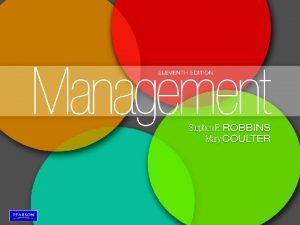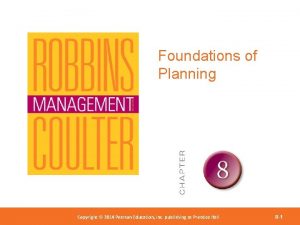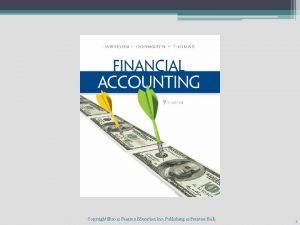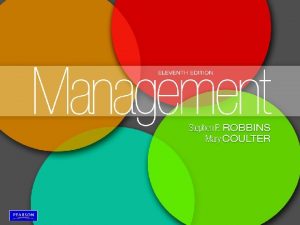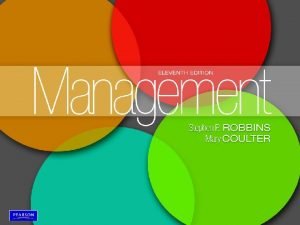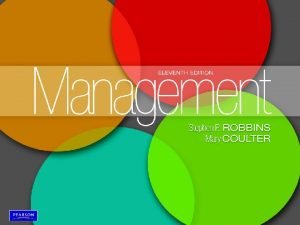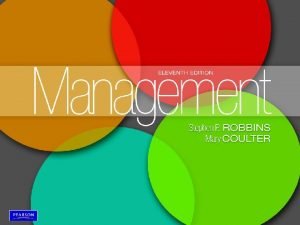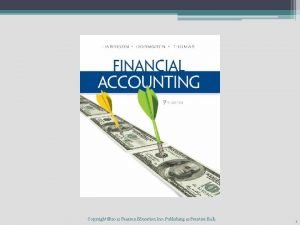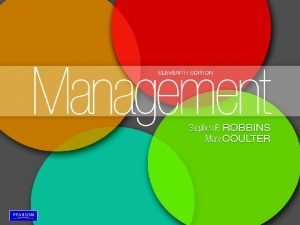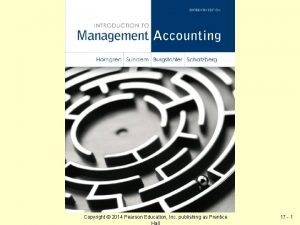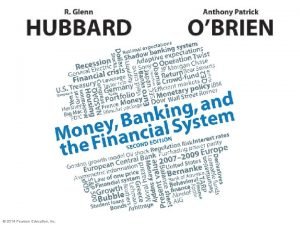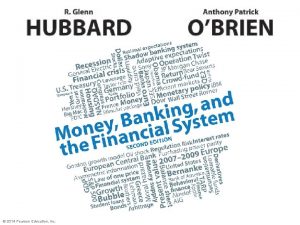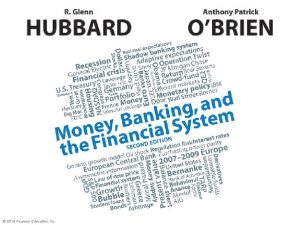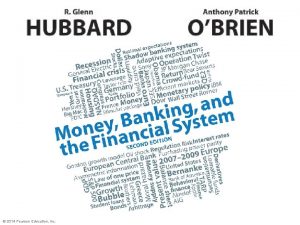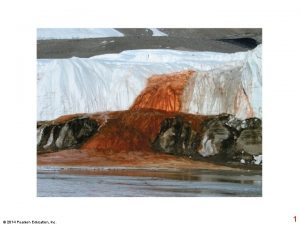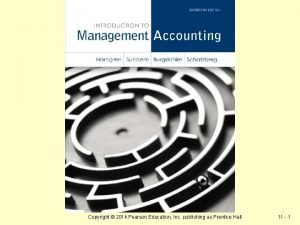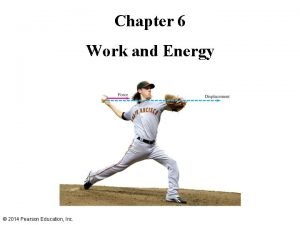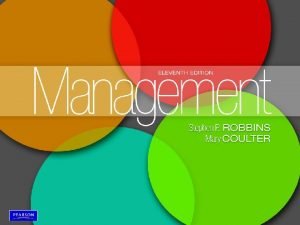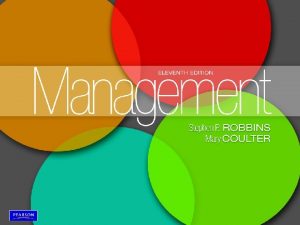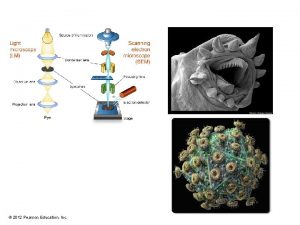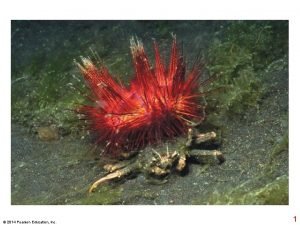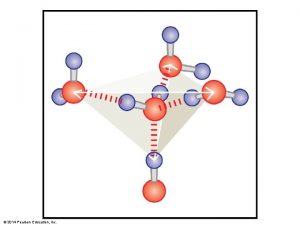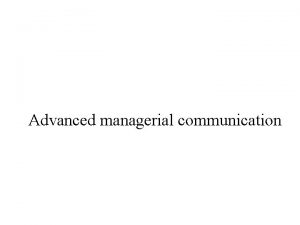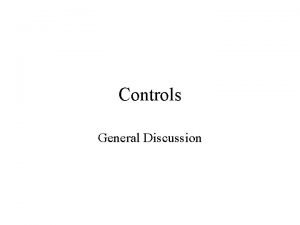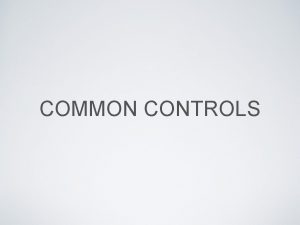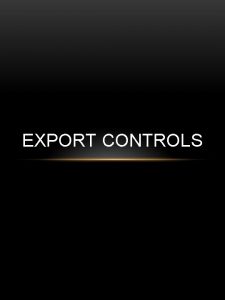Managerial Controls Copyright 2012 Pearson Education Copyright 2014






























- Slides: 30

Managerial Controls Copyright 2012 Pearson Education, Copyright © 2014 Pearson©Education, Inc. publishing as Prentice Hall Inc. Publishing as Prentice Hall 10 -1

Why Is Controlling Important? • As the final link in management functions: – Planning - controls let managers know whether their goals and plans are on target and what future actions to take. – Empowering employees - control systems provide managers with information and feedback on employee performance. – Protecting the workplace - controls enhance physical security and help minimize workplace disruptions. Copyright 2012 Pearson Education, Copyright © 2014 Pearson©Education, Inc. publishing as Prentice Hall Inc. Publishing as Prentice Hall 10 -2

Planning-Controlling Link Copyright 2012 Pearson Education, Copyright © 2014 Pearson©Education, Inc. publishing as Prentice Hall Inc. Publishing as Prentice Hall 10 -3

The Control Process • Control process - a three-step process of measuring actual performance, comparing actual performance against a standard, and taking managerial action to correct deviations or inadequate standards. Copyright 2012 Pearson Education, Copyright © 2014 Pearson©Education, Inc. publishing as Prentice Hall Inc. Publishing as Prentice Hall 10 -4

The Control Process (cont. ) • Step 1: Measuring Actual Performance – How We Measure - personal observations, statistical reports, oral reports, and written reports. – What We Measure - what is measured is probably more critical to the control process than how it’s measured. Copyright 2012 Pearson Education, Copyright © 2014 Pearson©Education, Inc. publishing as Prentice Hall Inc. Publishing as Prentice Hall 10 -5

Sources of Information for Measuring Performance Copyright 2012 Pearson Education, Copyright © 2014 Pearson©Education, Inc. publishing as Prentice Hall Inc. Publishing as Prentice Hall 10 -6

The Control Process (cont. ) • Step 2: Comparing Actual Performance Against the Standard – Determining the degree of variation between actual performance and the standard – Range of variation - the acceptable parameters of variance between actual performance and the standard. Copyright 2012 Pearson Education, Copyright © 2014 Pearson©Education, Inc. publishing as Prentice Hall Inc. Publishing as Prentice Hall 10 -7

Acceptable Range of Variation Copyright 2012 Pearson Education, Copyright © 2014 Pearson©Education, Inc. publishing as Prentice Hall Inc. Publishing as Prentice Hall 10 -8

New Professor Experimental Tests Test 1 = Average is 99% Test 2 = Average is 11% Copyright 2012 Pearson Education, Copyright © 2014 Pearson©Education, Inc. publishing as Prentice Hall Inc. Publishing as Prentice Hall 10 -9

The Control Process (cont. ) • Step 3: Taking Managerial Action – Immediate corrective action - corrective action that corrects problems at once in order to get performance back on track. – Basic corrective action - corrective action that looks at how and why performance deviated before correcting the source of deviation Copyright 2012 Pearson Education, Copyright © 2014 Pearson©Education, Inc. publishing as Prentice Hall Inc. Publishing as Prentice Hall 10 -10

The Control Process (cont. ) • Step 3 (cont. ) – Revise the Standard - if performance consistently exceeds the goal, then a manager should look at whether the goal is too easy and needs to be raised – Managers must be cautious about revising a standard downward – CLOSING THE LOOP Copyright 2012 Pearson Education, Copyright © 2014 Pearson©Education, Inc. publishing as Prentice Hall Inc. Publishing as Prentice Hall 10 -11

What Is Organizational Performance? • Performance - the end result of an activity. • Organizational performance - the accumulated results of all the organization’s work activities. Copyright 2012 Pearson Education, Copyright © 2014 Pearson©Education, Inc. publishing as Prentice Hall Inc. Publishing as Prentice Hall 10 -12

Measures of Organizational Performance • Productivity - the amount of goods or services produced divided by the inputs needed to generate that output. • Organizational effectiveness - a measure of how appropriate organizational goals are and how well those goals are being met. Copyright 2012 Pearson Education, Copyright © 2014 Pearson©Education, Inc. publishing as Prentice Hall Inc. Publishing as Prentice Hall 10 -13

Popular Industry and Company Rankings Copyright 2012 Pearson Education, Copyright © 2014 Pearson©Education, Inc. publishing as Prentice Hall Inc. Publishing as Prentice Hall 10 -14

1 5 International Organization for Standardization (ISO) Based in Switzerland – 159 member countries International standardization makes design and building and products cheaper and trade easier. Can get “certified” that your company follows these principles Done by independent reviewers

ISO 9000 The ISO 9000 family addresses “Quality Management, ” They fulfill: The customers quality requirements Enhance customer satisfaction Similar to “USDA approved”, but regarding management, not the products sold Recent amendments are called ISO 9001

1 7 ISO 9000 Demonstrate quality management principles 8 principles: – – – – Customer focus Leadership Involvement of people Process approach System approach to management Continual improvement Factual approach to decision making Mutually beneficial supplier relationship

ISO 14000 The ISO 14000 family addresses "Environmental management". What the organization does to Minimize harmful effects on the environment

1 9 Does ISO 14001 Help? Short term financial results, mixed Long term financial results, slight benefit Biggest benefit may be positive image 119 J. Bus. Ethics 131 (2014)

Controlling for Employee Performance • Disciplinary actions - actions taken by a manager to enforce the organization’s work standards and regulations. • Delivering Effective Performance Feedback managers need to provide their employees with feedback so that the employees know where they stand in terms of their work. Copyright 2012 Pearson Education, Copyright © 2014 Pearson©Education, Inc. publishing as Prentice Hall Inc. Publishing as Prentice Hall 10 -20

Problems = Employees Copyright 2012 Pearson Education, Copyright © 2014 Pearson©Education, Inc. publishing as Prentice Hall Inc. Publishing as Prentice Hall 10 -21

Tools for Measuring Organizational Performance • Feed forward control - control that takes place before a work activity is done. • Concurrent control - control that takes place while a work activity is in progress. • Management by walking around - a term used to describe when a manager is out in the work area interacting directly with employees. • Feedback control - control that takes place after a work activity is done. Copyright 2012 Pearson Education, Copyright © 2014 Pearson©Education, Inc. publishing as Prentice Hall Inc. Publishing as Prentice Hall 10 -22

Financial Controls • Traditional Controls – Ratio analysis • Liquidity • Leverage • Activity • Profitability – Budget Analysis • Quantitative standards • Deviations Copyright 2012 Pearson Education, Copyright © 2014 Pearson©Education, Inc. publishing as Prentice Hall Inc. Publishing as Prentice Hall 10 -23

The Balanced Scorecard • Balanced scorecard - a performance measurement tool that examines more than just the financial perspective. – Measures a company’s performance in four areas: • Financial • Customer • Internal processes • People/innovation/growth assets Copyright 2012 Pearson Education, Copyright © 2014 Pearson©Education, Inc. publishing as Prentice Hall Inc. Publishing as Prentice Hall 10 -24

Benchmarking of Best Practices • Benchmarking - the search for the best practices among competitors or non-competitors that lead to their superior performance. • Benchmark - the standard of excellence to measure and compare against. Copyright 2012 Pearson Education, Copyright © 2014 Pearson©Education, Inc. publishing as Prentice Hall Inc. Publishing as Prentice Hall 10 -25

Contemporary Issues in Control • Adjusting Controls for Cross-Cultural Differences and Global Turmoil – Control techniques can be quite different for different countries – Differences are primarily in the measurement and corrective action steps of the control process – Managers in foreign countries also need to be aware of constraints on corrective actions they can take. Copyright 2012 Pearson Education, Copyright © 2014 Pearson©Education, Inc. publishing as Prentice Hall Inc. Publishing as Prentice Hall 10 -26

Contemporary Issues in Control (cont. ) • Workplace privacy – Employers can (and do) • • • read your e-mail tap your telephone monitor your work by computer store and review computer files monitor you in an employee bathroom or dressing room • track your whereabouts in a company vehicle Copyright 2012 Pearson Education, Copyright © 2014 Pearson©Education, Inc. publishing as Prentice Hall Inc. Publishing as Prentice Hall 10 -27

Contemporary Issues in Control (cont. ) • Employee theft - any unauthorized taking of company property by employees for their personal use. • Workplace Violence - the U. S. National Institute of Occupational Safety and Health still says that each year, some 2 million American workers are victims of some form of workplace violence. Copyright 2012 Pearson Education, Copyright © 2014 Pearson©Education, Inc. publishing as Prentice Hall Inc. Publishing as Prentice Hall 10 -28

Controlling Workplace Violence Copyright 2012 Pearson Education, Copyright © 2014 Pearson©Education, Inc. publishing as Prentice Hall Inc. Publishing as Prentice Hall 10 -29

Controlling Workplace Violence (cont. ) Copyright 2012 Pearson Education, Copyright © 2014 Pearson©Education, Inc. publishing as Prentice Hall Inc. Publishing as Prentice Hall 10 -30
 2014 pearson education inc
2014 pearson education inc Pearson education, inc. publishing as prentice hall
Pearson education, inc. publishing as prentice hall 2012 pearson education inc
2012 pearson education inc Pearson education inc. 2012
Pearson education inc. 2012 2012 pearson education inc
2012 pearson education inc Cephalic cranial
Cephalic cranial 2012 pearson education inc
2012 pearson education inc Pearson education inc. 2012
Pearson education inc. 2012 2012 pearson education inc anatomy and physiology
2012 pearson education inc anatomy and physiology 2012 pearson education inc
2012 pearson education inc 2012 pearson education inc
2012 pearson education inc 2012 pearson education inc
2012 pearson education inc 2012 pearson education inc
2012 pearson education inc Pearson education 2012
Pearson education 2012 Pearson education inc. 2012
Pearson education inc. 2012 2012 pearson education inc
2012 pearson education inc 2012 pearson education inc
2012 pearson education inc Pearson education 2012
Pearson education 2012 Pearson education inc. 2012
Pearson education inc. 2012 2012 pearson education inc
2012 pearson education inc 2014 pearson education inc
2014 pearson education inc 2014 pearson education inc
2014 pearson education inc 2014 pearson education inc
2014 pearson education inc 2014 pearson education inc
2014 pearson education inc 2014 pearson education inc
2014 pearson education inc 2014 pearson education inc
2014 pearson education inc 2014 pearson education inc
2014 pearson education inc 2014 pearson education inc
2014 pearson education inc 2014 pearson education inc
2014 pearson education inc 2014 pearson education inc
2014 pearson education inc 2014 pearson education inc
2014 pearson education inc




